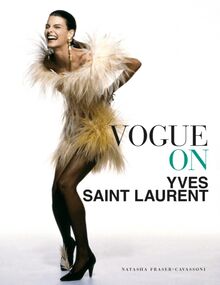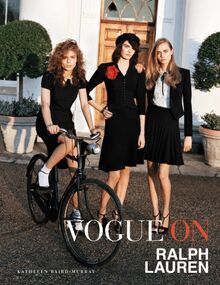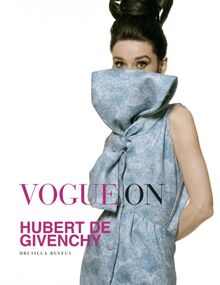-
 Univers
Univers
-
 Ebooks
Ebooks
-
 Livres audio
Livres audio
-
 Presse
Presse
-
 Podcasts
Podcasts
-
 BD
BD
-
 Documents
Documents
-
- Cours
- Révisions
- Ressources pédagogiques
- Sciences de l’éducation
- Manuels scolaires
- Langues
- Travaux de classe
- Annales de BEP
- Etudes supérieures
- Maternelle et primaire
- Fiches de lecture
- Orientation scolaire
- Méthodologie
- Corrigés de devoir
- Annales d’examens et concours
- Annales du bac
- Annales du brevet
- Rapports de stage
La lecture à portée de main
Vogue on Hubert de Givenchy , livre ebook
159
pages
English
Ebooks
2015
Écrit par
Beyfus Drusilla
Publié par
ABRAMS BOOKS
Vous pourrez modifier la taille du texte de cet ouvrage
Obtenez un accès à la bibliothèque pour le consulter en ligne En savoir plus
Découvre YouScribe en t'inscrivant gratuitement
Découvre YouScribe en t'inscrivant gratuitement
159
pages
English
Ebook
2015
Vous pourrez modifier la taille du texte de cet ouvrage
Obtenez un accès à la bibliothèque pour le consulter en ligne En savoir plus
Publié par
Date de parution
06 octobre 2015
Nombre de lectures
9
EAN13
9781613128213
Langue
English
Poids de l'ouvrage
5 Mo
Publié par
Date de parution
06 octobre 2015
Nombre de lectures
9
EAN13
9781613128213
Langue
English
Poids de l'ouvrage
5 Mo
Audrey Hepburn shows off Givenchy s short dinner dress of yellow silk, embroidered in mother of pearl and crystal. Shaped by informed cutting, says Vogue, that gives a delicious roundness to the skirt. Photograph by Bert Stern, 1963 .
Fitting black satin straight to the floor, plume of black feathers, writes Vogue on this little black dress by Givenchy. Photograph by Bruce Weber, 1982 .
Audrey Hepburn with Hubert de Givenchy on the set of the movie Funny Face. Photograph by David Seymour, 1956 .
BIRTH OF A COUTURIER
THE IMAGE MAKERS
GIVENCHY STYLE
DIVERSE INFLUENCES
TRIUMPHS AND REVERSES
Index of Searchable Terms
References
Picture credits
Acknowledgments
A BRILLIANT HAND WITH SEPARATES.
VOGUE
BIRTH OF A COUTURIER
A
W hen, as a young man, Hubert de Givenchy was invited to grand dances, he sat out because he didn t dance. He has said he spent the time looking. There was much to catch his eye. The newly optimistic mood in Paris that followed the Liberation in the late 1940s heralded a flurry of balls, tactfully held in aid of war charities. Vogue Paris published in color the Bal des Oiseaux at the Palais Rose in November 1948, the writer extolling the shimmering tones and glints of the tropical theme in a winter season. Pyramids of flowers and gilded branches decorated the ballroom, birds taken from their glass domes, perched like jewels on arboreal resting places. Among titled members of old French families could be seen Elsa Schiaparelli, her headdress and fingernails in Shocking Pink, the dancer and singer Josephine Baker wrapped in a feather boa, and the artist Christian B b B rard. Prince Jean-Louis de Faucigny-Lucinge wrote of the period, Never, since the Age of Enlightenment has society found itself so close to artists. Guests proceeded up the great staircase of pink and gray marble to the reception rooms, admiring each other s feathered masks, fans, and headdresses. Among the photographed guests was Hubert de Givenchy.
The young Frenchman, born 1927, was the scion of an aristocratic family of practicing Protestants in northern France. A distinguishing physical characteristic was his great height, standing at 78 inches. Handsome and said to be rather shy, he had a courteous demeanor. At the ball he can be seen as extending his apprenticeship in his chosen vocation, haute couture. His interest in women s fashion and fabrics had roots in childhood curiosity, and was to lead to a forty-year pursuit of what he deemed the most beautiful metier and his becoming one of the outstanding masters among a generation of couturiers that dominated fashion in Paris after the Second World War.
A long view of Givenchy in the pages of Vogue shows how much dress design owes him. His work carries on the historic traditions of haute couture as practiced by his mentor and idol, Crist bal Balenciaga, the Spanish master.
Hubert de Givenchy at the studio of his first salon, rue Alfred de Vigny, Paris, in the early Fifties. He is perfecting the shirring (gathers) on a work in progress, modeled in house .
Givenchy s high-waist, minimum bodice (left) in white satin; a sash wraps the midriff underscoring a high ruffled d colletage. A short evening dress (right) bells with a minute off-the-shoulder bodice. Illustration by Al Bouret, 1958 .
British Vogue rated this dark fitted suit an absolute classic for its neat silhouette. Hat and gloves too are by Givenchy. Photograph by Alex Chatelain, 1989 .
A
IN BREAKFAST AT TIFFANY S HUBERT DE GIVENCHY S ICONIC BLACK DRESS FOR AUDREY HEPBURN HAS ENTERED FASHION HISTORY.
VICTORIA ALBERT MUSEUM HOLLYWOOD COSTUME, 2012
A poster of Audrey Hepburn in Givenchy s emblematic black sheath for her character as Holly Golightly in Breakfast at Tiffany s, 1961. Directed by Blake Edwards, the movie is based on a story by Truman Capote. Audrey has said Clothes have given me the confidence I often needed.
To Susan Train, Vogue s American editor in Paris, Givenchy came to personify not only the continuity of post-Second-World-War haute couture, but also links with the traditional prewar couture. He may not have moved the tectonic plates of fashion, but there s a strong case for recognizing his creative consistency in a period of almost wanton stylistic change. Always the perfectionist, his style is hard to define, as the classicism that was his bent breaks out from time to time into playfulness, fantasy, and surprise. Women have to thank him for the emphasis on comfort, a significant consideration since he worked at a time when Paris couture still cast a kindly eye on the corset and tight bodice. Fabrics he regarded with the scrutiny of an artist, seeing them as primary inspiration for forward thinking. Unusual materials inspired him, as did innovative combination of textures and types. He also helped develop the application of synthetics such as Lurex and Orlon. Above all, he intuited the female sartorial psyche. He really did know what women want. A Givenchy coat would be most women s ideal of the perfect way to look in daytime, commented British Vogue in 1960. It could have been said a thousand times in Vogue s coverage of the designer, whatever the intended hour of the piece.
Also due to his hand are some supremely stylish moments in modern dress in movie production. Hubert de Givenchy and Audrey Hepburn met in connection with the costumes she was to wear in one of her Hollywood movies, an encounter that ricocheted across the boundaries of fashion and show business. In the process, Givenchy s designs (but not Givenchy himself) won an Oscar and the leading lady became his muse, friend, and the personification of his style. To name but one of his sartorial hits in Hepburn s movies, who can forget Holly Golightly s Little Black Dress in the opening shots of Breakfast at Tiffany s ? It s a model of the form.
Sometimes a single millimeter is all it takes.
CATHERINE JOIN-DI TERLE
French cut string bean, was how American Vogue viewed Givenchy s black jersey dinner sheath. It possessed, no collar, no back, no nothing but terrific shape. Photograph by John Rawlings, 1953 .
G ivenchy has said that to dress a woman is to enhance her beauty, and I questioned him on the matter in an interview. Trying to make a woman more beautiful is to try to understand her well, for her to be well dressed and above all, comfortable in her clothes. If a woman moves well, her gestures will be natural and she will be happy, he commented. Clothes can change many things in the life of a woman. Many of my clients have told me that when they met the man of their life, they wore a little plain Givenchy dress and it helped them conquer their future husband. Perhaps this is a compliment that these clients and friends wanted to pay me, but I also know that there is some real evidence for this testimony.
It has also has to be said that a little plain Givenchy dress conceals the intense craftsmanship that goes into its magic. Here is an account of a model that the imagined client or friend might have been wearing. British Vogue and Vogue Paris in September 1955 gave a full page to a shot by Henry Clarke of the couturier s Long, Lean Dress. It was captioned, Superbly detailed arrow-slim interpretation of the pared down minimum, collarless, short sleeved, his oatmeal tweed dress has a semi-fitted diagonally seamed waistline, is high-necked, flat in front. What may also have had a bearing on the case of the aforesaid smitten spectator is the creator s observation that In haute couture we are cosmetic surgeons, erasing imperfections and refining the silhouette.
When people reference Givenchy today it tends to be in classical terms. He didn t do sartorial bombshells, avoided street style, and wasn t tempted by the raunchy. However, we can see him as the precursor of that most contemporary phenomenon, the entrepreneur designer who is the brand. Vogue portrays his house style as elegant, refined, and cultured-qualities that others have recognized in the man. As a couturier and in private life he inhabited the realms of high fashion, high art, and high society, all of which come to mind in connection with his label. He acted as his own ambassador, using his strengths. It s not disrespectful to say that few of his compatriot designers would fit the description accorded him in American Vogue in the mid-sixties as being handsomer than almost any movie star. Vogue has seen him as couturier, costume designer, interior decorator, art connoisseur, fashion model, perfumery and cosmetic producer, company director and, also, as a member of fashionable society. His country houses and private Paris domain as well as his art collections attest to the joined-up nature of his aesthetic. And it goes without saying that whatever the public event or occasion or location at which he appeared, he was perfectly dressed for it.
British Vogue liked the pared down minimum of Givenchy s couture day dress, shown in oatmeal tweed. With its tailored fit, a small tongue of a collar, and solo button the design is recognized as one of his best. Its long, lean look is accompanied by a plumb straight hat in beige leather and white cuffed gloves. Photograph by Henry Clarke, 1955 .
Italian fashion illustrator Ren Gruau s retrospective drawing of The Bettina blouse, named after the model who showed it at Givenchy s launch collection. Bettina Graziani attracted the eye of the Press in a design made-most unusually in Paris couture-of low-status cotton shirting. The sleeves burst into double ruffles embroidered in black eyelets .
T he launch of the House of Givenchy on February 2, 1952 at 8, rue Alfred de Vigny, an 1860 Gothic building near Parc Monceau, marked the beginning of Vogue s empathetic and consistent coverage of the designer. Opening to a jubilant if chaotic reception, it channeled innovation. How very different the atmosphere must have been from that at the great reigning houses. There, the wonde

Ebooks
Vogue on Yves Saint Laurent
Fraser-Cavassoni Natasha

Ebooks
Photographie
Vogue on Yves Saint Laurent
Fraser-Cavassoni Natasha
159 pages
English

Ebooks
Vogue on Ralph Lauren
Baird-Murray Kathleen


Ebooks
Vogue on Hubert de Givenchy
Beyfus Drusilla

-
 Univers
Univers
-
 Ebooks
Ebooks
-
 Livres audio
Livres audio
-
 Presse
Presse
-
 Podcasts
Podcasts
-
 BD
BD
-
 Documents
Documents
-
Jeunesse
-
Littérature
-
Ressources professionnelles
-
Santé et bien-être
-
Savoirs
-
Education
-
Loisirs et hobbies
-
Art, musique et cinéma
-
Actualité et débat de société
-
Jeunesse
-
Littérature
-
Ressources professionnelles
-
Santé et bien-être
-
Savoirs
-
Education
-
Loisirs et hobbies
-
Art, musique et cinéma
-
Actualité et débat de société
-
Actualités
-
Lifestyle
-
Presse jeunesse
-
Presse professionnelle
-
Pratique
-
Presse sportive
-
Presse internationale
-
Culture & Médias
-
Action et Aventures
-
Science-fiction et Fantasy
-
Société
-
Jeunesse
-
Littérature
-
Ressources professionnelles
-
Santé et bien-être
-
Savoirs
-
Education
-
Loisirs et hobbies
-
Art, musique et cinéma
-
Actualité et débat de société
- Cours
- Révisions
- Ressources pédagogiques
- Sciences de l’éducation
- Manuels scolaires
- Langues
- Travaux de classe
- Annales de BEP
- Etudes supérieures
- Maternelle et primaire
- Fiches de lecture
- Orientation scolaire
- Méthodologie
- Corrigés de devoir
- Annales d’examens et concours
- Annales du bac
- Annales du brevet
- Rapports de stage





